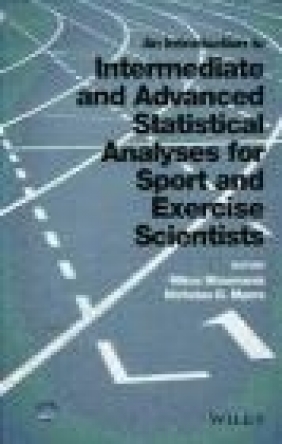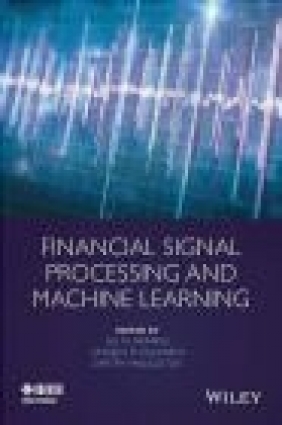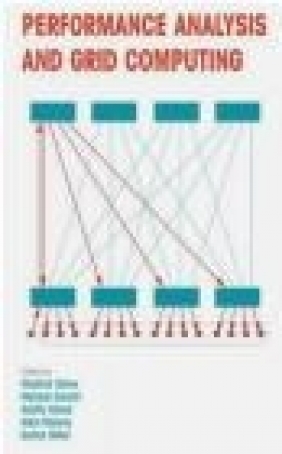An Introduction to Intermediate and Advanced Statistical Analyses for Sport and Exercise Scientists
Nicholas Myers, Nikos Ntoumanis
An Introduction to Intermediate and Advanced Statistical Analyses for Sport and Exercise Scientists
Nicholas Myers, Nikos Ntoumanis
- Wydawnictwo: John Wiley
- Rok wydania: 2016
- ISBN: 9781118962053
- Ilość stron: 312
- Oprawa: Twarda
Niedostępna
Opis: An Introduction to Intermediate and Advanced Statistical Analyses for Sport and Exercise Scientists - Nicholas Myers, Nikos Ntoumanis
Ntoumanis and Myers have done sport and exercise science researchers and students a tremendous service in producing An Introduction to Intermediate and Advanced Statistical Analyses for Sport and Exercise Scientists. This book has an outstanding compilation of comprehensible chapters dealing with the important concepts and technical minutia of the statistical analyses that sport and exercise science scholars use (or should be using!) in their efforts to conduct meaningful research in the field. It is a resource that all sport and exercise scientists and their students should have on their book shelves. Robert Eklund, School of Sport, University of Stirling, UK Motivating, to have a statistics text devoted to enabling researchers studying sport and exercise science to apply the most sophisticated analytical techniques to their data. Authors hit the mark between using technical language as necessary and user-friendly terms or translations to keep users encouraged. Text covers traditional and well-used tools but also less common and more complex tools, but always with familiar examples to make their explanations come alive. As a dynamic systems theorist and developmentalist, I would love to see more researchers in my area create study designs that would enable the use of tools outlined here, such as multilevel structural equation modeling (MSEM) or mediation & moderation analyses, to uncover cascades of relations among subsystems contributing to motor performance, over time. This text can facilitate that outcome. Beverly D. Ulrich, School of Kinesiology, University of Michigan, USA The domain of quantitative methods is constantly evolving and expanding. This means that there is tremendous pressure on researchers to stay current, both in terms of best practices and improvements in more traditional methods as well as increasingly complex new methods. With this volume Ntoumanis and Myers present a nice cross-section of both, helping sport and exercise science researchers to address old questions in better ways, and, even more excitingly, to address new questions entirely. I have no doubt that this volume will quickly become a lovingly dog-eared companion for students and researchers, helping them to continue to move the field forward. Gregory R. Hancock, University of Maryland and Center for Integrated Latent Variable Research (CILVR), USAAbout the editors xiii List of contributors xv Foreword xix Preface xxi 1 Factorial ANOVA and MANOVA 1 General Introduction 1 Hypothesis Testing 2 Alpha Level 2 Assumptions 3 Further Considerations 4 Utility in Sport and Exercise Sciences 6 Treatment Conditions 6 Existing Conditions 6 Individual Characteristics 7 Recent Usage 7 The Substantive Example 7 Univariate: Factorial ANOVA 8 Univariate Assumptions 8 The Synergy 10 Factorial ANOVA Analysis Plan 10 Example of a Write ]Up Compatible with the APA Publication Manual 11 Factorial MANOVA Analysis Plan 13 Example of a Write ]Up Compatible with the APA Publication Manual 13 Summary 16 Acknowledgment 18 References 18 2 Repeated measures ANOVA and MANOVA 19 General Introduction 19 Between ] versus Within ]Subjects Variables 19 Hypothesis Testing 20 Assumptions 20 Further Considerations 21 Utility in Sport and Exercise Sciences 22 Multiple Treatment Conditions 23 Multiple Assessments 23 Longitudinal Studies 23 Recent Usage 24 The Substantive Example 24 Univariate: Repeated Measures ANOVA 24 Univariate Assumptions 25 Multivariate: Repeated Measures MANOVA 26 Multivariate Assumptions 26 The Synergy 27 Repeated Measures ANOVA Analysis Plan 27 Example of a Write ]Up Compatible with the APA Publication Manual 29 Repeated Measures MANOVA Analysis Plan 29 Example of a Write ]Up Compatible with the APA Publication Manual 31 Summary 32 Acknowledgment 34 References 34 3 Mediation and moderation via regression analysis 35 General Introduction 35 Utility of the Methods in Sport and Exercise Science 36 The Substantive Example 38 Mediation 38 The Synergy 38 Mediation 38 The Substantive Example 44 Moderation 44 The Synergy 45 Moderation 45 Summary 53 References 55 4 Item response theory and its applications in Kinesiology 57 General Introduction 57 What Is IRT? 59 Other Commonly Used IRT Models 60 Assumptions Related to IRT 62 Unidimensionality 62 Local Independence 62 Addressing Model ]Data Fit 62 Inspecting Model Assumptions 63 Inspecting Expected Model Features 63 Inspecting Overall Model ]Data Fit 64 Computer Simulation for Model ]Data Fit Testing 64 Unique Features and Advantages of IRT 65 Estimation Invariance 65 Common Metric Scale 65 Item and Test Information 66 Test Relative Efficiency 68 Global Reliability Is no Longer a Concern 69 Item Bank and IRT ]Based Test Construction 69 Parameter Estimation and Software 71 Utility of the Methodology in Kinesiology 71 IRT Limitations and Future Direction 72 Conclusion 73 References 74 5 Introduction to factor analysis and structural equation modeling 79 General Introduction 79 Utility of the Method in Sport and Exercise Science 80 Terminology and Methodology 83 Evaluating Model Fit 86 Interpreting Parameter Estimates 88 The Substantive Example 89 The Synergy 91 EFA: Establishing the Factor Structure 91 CFA: Testing the Measurement Models 93 Structural Equation Modeling: Adding the Regression Paths 96 Summary 98 References 99 6 Invariance testing across samples and time: Cohort ]sequence analysis of perceived body composition 101 General Introduction to the Importance of Measurement Invariance 102 Cohort ]Sequential Designs: Longitudinal Invariance across Samples and Time 106 Substantive Application: Physical Self ]Concept 107 Methodology 111 The PSDQ Instrument 111 Statistical Analyses 111 Goodness of Fit 112 Results 113 Basic Cohort ]Sequence Model: Four Cohort Groups and Four Waves 113 Cohort ]Sequence Design of Multiple Indicators, Multiple Causes Models 115 Use of Model Constraint with Orthogonal Polynomial Contrasts to Evaluate Cohort Sequence and MIMIC Latent Means 116 Use of Latent Growth Curve Models to Evaluate Stability/Change over Time 119 LGC Results 123 Summary, Implications, and Further Directions 123 Methodological Implications, Limitations, and Further Directions 123 References 125 7 Cross ]lagged structural equation modeling and latent growth modeling 131 General Introduction 131 A Theoretical Framework for the Study of Change 132 Utility of the Method in Sport and Exercise Science 132 Analysis of Change 132 The Substantive Example 134 Theoretical Background 134 The Data: Participants and Measurement 134 The Synergy 135 CLPM 135 CLPM Example 137 Latent Growth Modeling 140 LGM Example 141 Model 2a: Unconditional LGM 143 Model 2b: Conditional LGM 145 Model 2c: Unconditional LGM with TVCs 145 Model 3: Parallel Process LGM 146 Model 4: Second ]Order LGM 148 Summary 150 References 151 8 Exploratory structural equation modeling and Bayesian estimation 155 General Introduction 155 Utility of the Methods in Sport and Exercise Science 156 The Substantive Example(s) 159 The Motivational Correlates of Mentally Tough Behavior 159 Developing Synergies through Statistical Modeling 161 ESEM 161 Bayesian Estimation 168 Summary 179 References 180 9 A gentle introduction to mixture modeling using physical fitness performance data 183 General Introduction 183 Utility of the Method in Sport and Exercise Science 186 The Substantive Example(s) 187 Class Enumeration in Mixture Models 188 The Estimation of Mixture Models 190 The Synergy 190 LPA of Grade 5 Students and Tests of Invariance across Gender Groups 190 Inclusion of Covariates in LPA Solutions 195 LTA 196 Mixture Regression Analyses of Grade 5 Students 198 Latent Basis Growth Mixture Analyses: Cardiovascular Fitness 202 Piecewise Growth Mixture Analyses: Physical Strength 203 Summary 204 Acknowledgments 205 References 206 10 Multilevel (structural equation) modeling 211 General Introduction 211 Multilevel Structural Equation Modeling 212 Utility of the Methodology in Sport and Exercise Science 214 The Substantive Examples 215 Coaching Competency Collective Efficacy Team Performance: 1 1 2 216 Action Planning Intervention Physical Activity Action Plans Physical Activity: 2 1 1 217 The Synergy 218 Coaching Competency Collective Efficacy Team Performance: 1 1 2 219 Action Planning Intervention Physical Activity Action Plans Physical Activity: 2 1 1 222 Summary 229 References 230 11 Application of meta ]analysis in sport and exercise science 233 General Introduction 233 Stages of Meta ]Analysis 233 Key Elements of Meta ]Analysis 234 Goals of Meta ]Analysis 236 Utility of the Methodology in Sport and Exercise Science 238 The Substantive Example 238 The Synergy 241 Univariate Meta ]Analysis 241 Multivariate Meta ]Analysis 245 Summary 249 Acknowledgment 251 References 251 12 Reliability and stability of variables/instruments used in sport science and sport medicine 255 Introduction 255 A. Assessment of Test Retest Agreement Using Interval/Ratio Data 256 A Worked Example Using the Test Retest Differences of the Biceps Skinfold Measurements 257 B. Utility of the Assessment of Test Retest Stability Using Categorical/Likert ]Type Data 260 The Substantive Example 261 Utility of the Test Retest Stability Using Nonparametric Data 261 The Synergy 262 Utility of the Item by Item Approach to Test Retest Stability 263 The Synergy 263 Summary 265 References 266 13 Sample size determination and power estimation in structural equation modeling 267 General Introduction 267 Power 268 Power Analysis in SEM 268 Utility of the Methodology in Sport and Exercise Science 269 Power Analysis Regarding Model ]Data Fit: An Introduction 269 Power Analysis Regarding Focal Parameters: An Introduction 270 The Substantive Example 272 Bifactor Model in Sport and Exercise Science 272 Bifactor Model and the PETES 273 The Synergy 275 Power Analysis Regarding Model ]Data Fit: A Demonstration 276 Power Analysis Regarding Focal Parameters: A Demonstration 278 Summary 281 References 282 Index 285
Szczegóły: An Introduction to Intermediate and Advanced Statistical Analyses for Sport and Exercise Scientists - Nicholas Myers, Nikos Ntoumanis
Tytuł: An Introduction to Intermediate and Advanced Statistical Analyses for Sport and Exercise Scientists
Autor: Nicholas Myers, Nikos Ntoumanis
Wydawnictwo: John Wiley
ISBN: 9781118962053
Rok wydania: 2016
Ilość stron: 312
Oprawa: Twarda
Waga: 0.59 kg






























